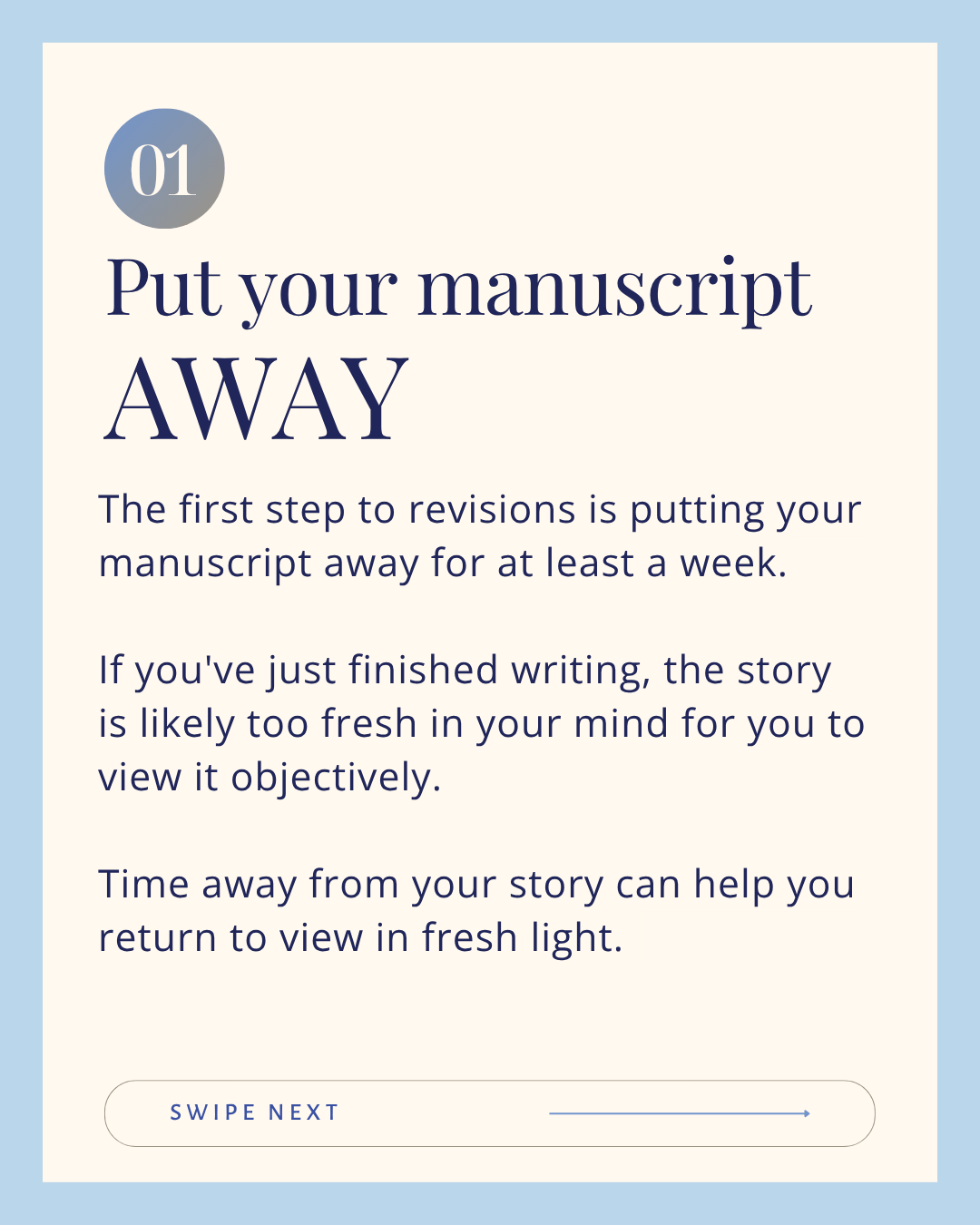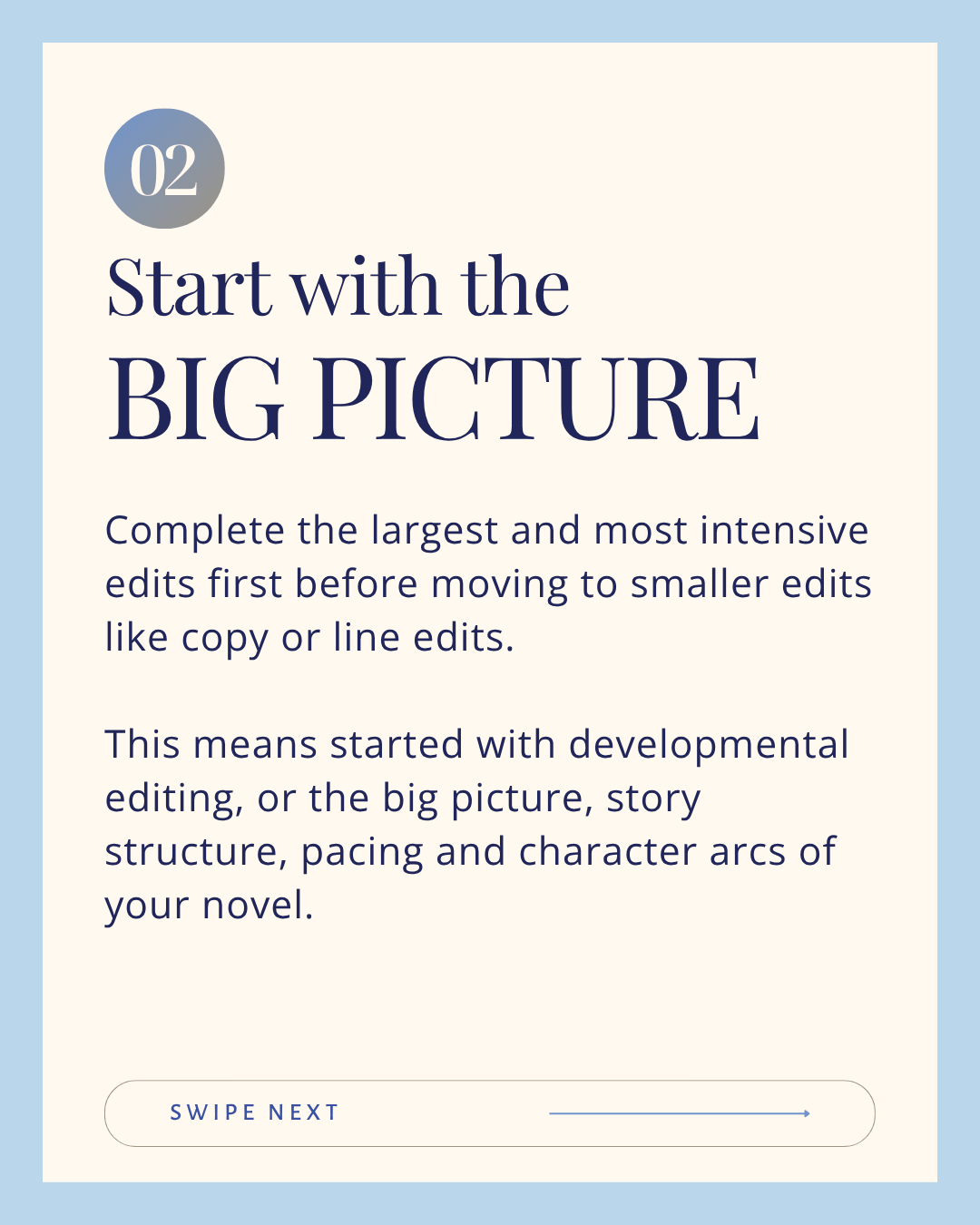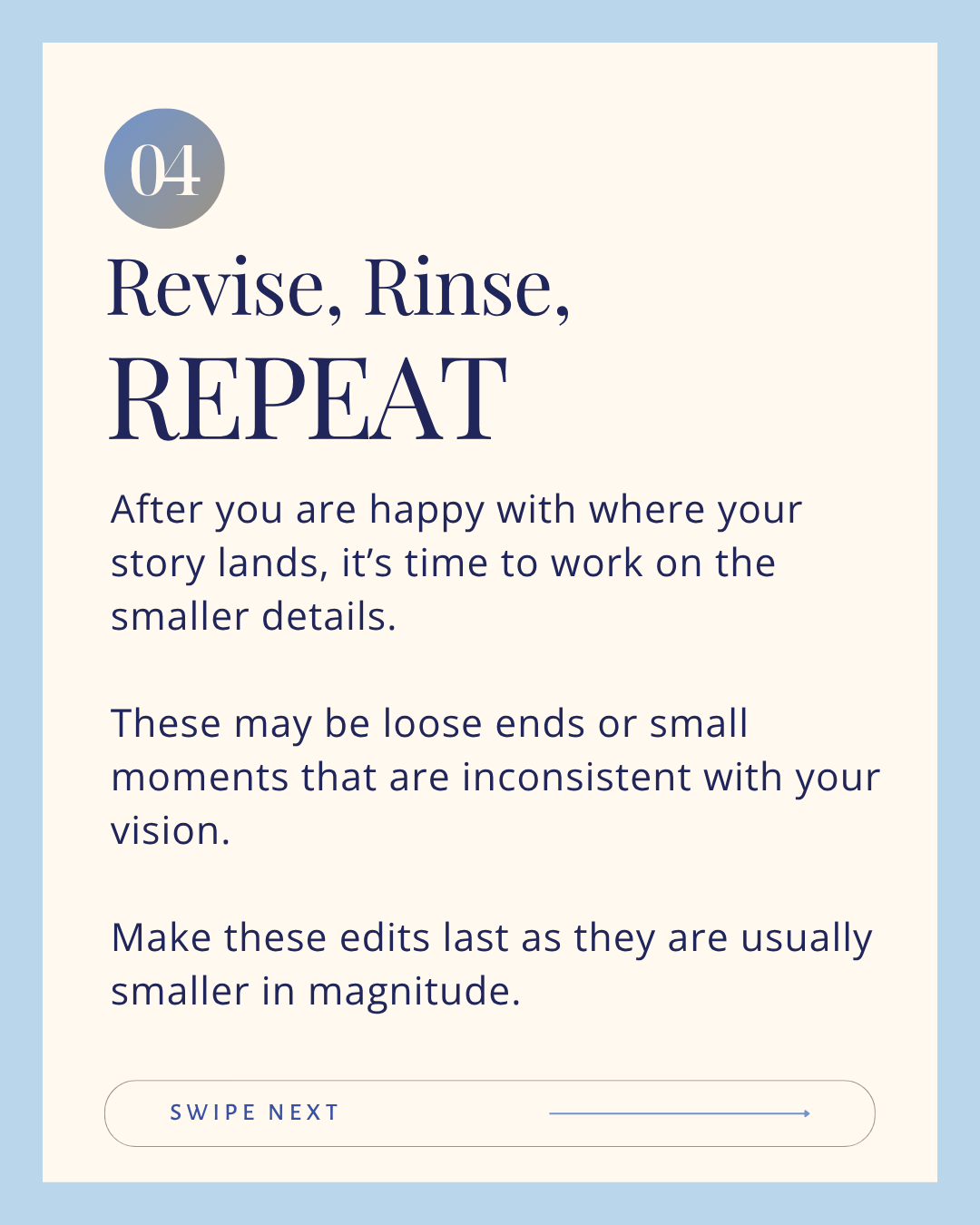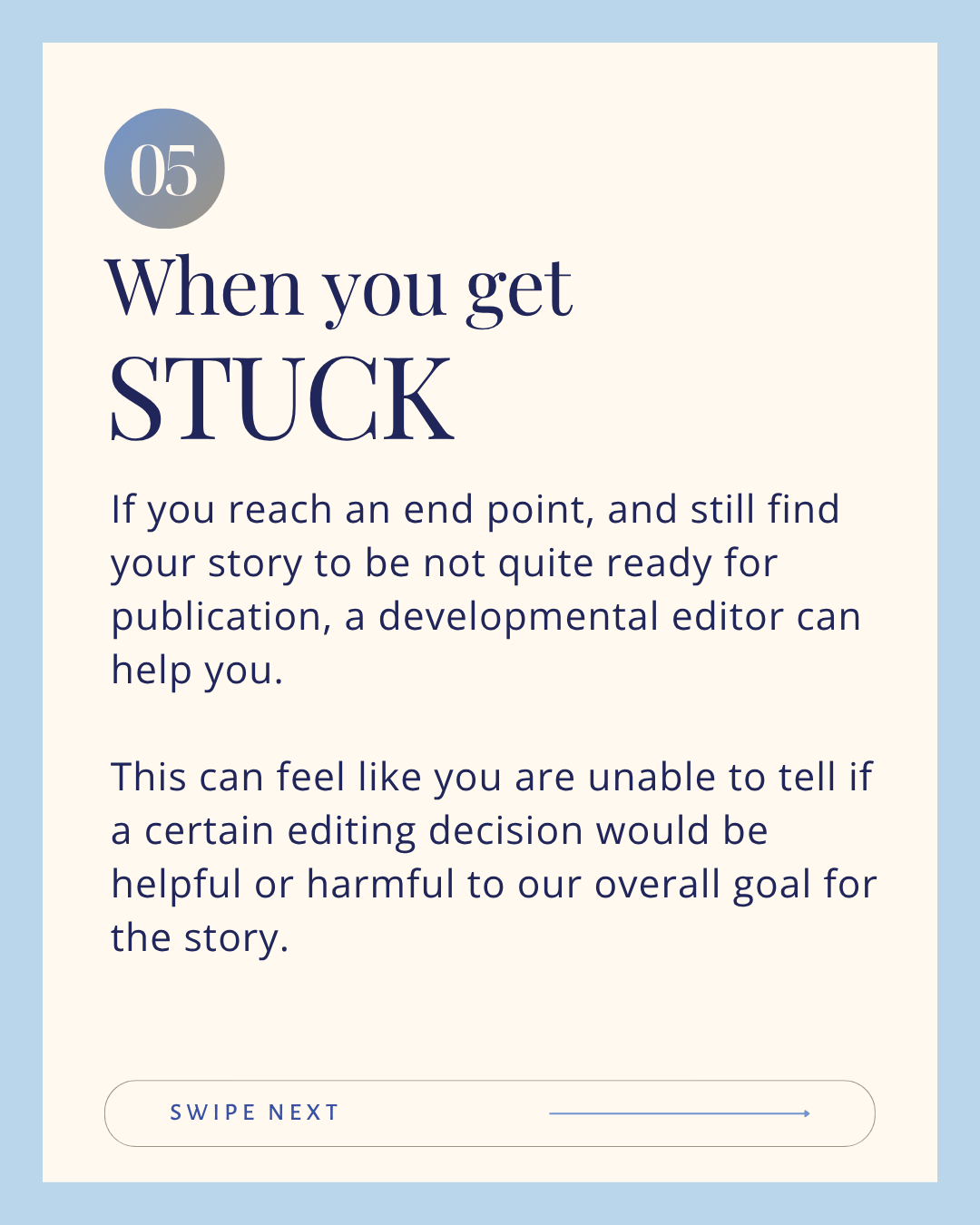The Book Editing Process: How to Edit Your Novel
Editing your book is a daunting task. If it's your first time going through this process, you are not alone. My goal is to demystify the editing process to give you a clear guide on how to start revising your novel. Every writer has a different process they use to edit a book. You'll have to find the steps that work best for you. I am here to give you tips from someone who edits books every day as to what I use when I look at a manuscript for the first time.
Before you get started, be sure to download my free self-editing checklist in order to guide you on your journey. This is a guide to your big picture self-edit.
Whether you are self-publishing, seeking representation from agents, or pursuing traditional publishing, the quality of your completed manuscript is your responsibility. Every writer has a dream of writing a clean first draft and avoiding the treacherous fate of rewrites. However, this is not reality for the vast majority of writers. in other words, every book you've ever loved once started out as a messy early draft.
Let me take you through the process of getting from first draft to final draft.
So you've finished your first draft, now what?
You've typed the best words and author can ever write, "the end." Your completed draft stares back at you, expecting something. But you have no idea where to start, never fear!
The first step to revisions is putting your manuscript away for at least a week. If you've just finished writing, the story is likely too fresh in your mind for you to view it objectively. Time away from your story can help you return to view in fresh light.
Once your story has rested in a drawer for a while, it's time for a first read. I recommend conducting this in the same format that you consume books normally, whether that be via e-reader, hard copy or another format. Overall, it's a good idea to look at your story from a different perspective than what you wrote it in. This will help you catch typos and view your story from the reader's experience. Read your book completely in one sitting without making any edits.
As you complete this first read, take detailed notes on how you experienced the story. These initial reactions will be crucial data for your process and you will only be able to read your story so many times before you lose the ability to identify a reader's experience. Beta readers can be a helpful solution if you reach this point. If you've read your story too many times and can no longer distinguish the highlights from the opportunities for improvement, it's time to get some outside feedback.
The Book Editing Process:
When you start to edit a novel, it's a best practice to complete the largest and most intensive edit first before moving to smaller edits like copy or line edits. This means started with developmental editing, or the big picture, story structure, pacing and character development of your novel.
This is the stage of the edit where you focus on the entire manuscript, rather than the punctuation or comma placement.
And in my incredibly biased opinion, it's also the most important step in writing an unforgettable novel. A book can have spelling errors, or a few clunky sentences, and still succeed. However, a novel with no story is like a train off the tracks. It's just not going to go anywhere.
I'll talk a little bit more about developmental editing in a bit, since it is my specialty. However, I want to give you an idea of the total process before diving into one type of edit specifically.
Next up, you have line editing, where you'll examine your book at the line level for syntax, flow, and style. The next edit is a copy edit, which cleans up your manuscript's grammar and spelling. Finally, your book will undergo a proofread to catch any last minute errors.
Once all of these stages are complete, you will be ready to publish a book.
Sound like a lot? You bet it is! Remember if it was easy, everyone would do it. Only 3% of folks who say they want to write a book ever finish a first. That means if you are here, you already completed the hard part (writing a novel) and are ready to take on the next challenge (learning how to edit).
Self-Editing Your Book: A Step-by-Step Guide:
Step 1: Get Clear on Your Theme
There's a couple of things that you need to get out of the way before you turn your first draft into a second draft. I work with all my retainer clients to get to the heart of their story before we tackle any substantive edits. What is the heart of your story, you might be wondering?
Well, it's your theme.
Your theme is derived from all the parts of your story working together to create a cohesive message for your audience. The theme tells us what this story is really about and is framed by the big choice that your protagonist must make by the end. It's also incredibly useful in writing our one-sentence pitch, but that's another blog post. Here's my formula for identifying the theme of your novel:
Will [protagonist] learn [Internal lesson] and [External Stakes if they succeed] or will they [External stakes if they fail] and fail to understand that [internal lesson]?
For example, Will Feyre learn to love the fae and save them from Amarantha or will she leave them all to suffer under the mountain and hold on to her hatred?
Will Katniss learn to rely on others and survive the Hunger Games or will she work alone and die?
This question is the guiding light when it comes to your vision for your story. If something does not support this narrative thread, then it is likely distracting your reader from experiencing the full emotional weight of your book.
Step 2: Promise, Progress, & Payoff
Next, it's time to take a look at your plot. I start with plot when editing because if there is a glaring hole in the logical progression of the external story events, I want to identify it right away because it will likely require the largest substantive edits.
When thinking about plotting, one of my favorite methods comes from Brandon Sanderson (you can find his entire creative writing lectures on YouTube). He considers the idea of initial promises made to the reader in Act One, definable progress that the reader can articulate towards solving the external plot problem, and a payoff that achieves a satisfying resolution to the external plot problem.
The promise you make to your reader is important because it shapes their expectations. Picture this, you go to a bakery and pick up a donut. After you leave, you open the bag to find that you’ve been given a bagel. It’s not what you wanted, even if you like bagels. Stories are the same way. If your reader picks up a novel expecting a swoon-worthy romance, and instead they get a high-stakes science fiction action story, they’re going to be confused even if they like action stories. This is because readers are constantly on the lookout for clues on how the story will end. As they read, their brain is on a constant loop of “Why does this matter?” as they transit the story via the protagonist. A reader with a romance book in their hands is going to interpret information in search of the main couple’s romantic outcomes. A reader with an action book in their hands is going to look for context as to whether or not the protagonist defeats the bad guy and survives. The promises you make at the beginning of your story matter.
Progress is defined by your reader's ability to measure how close the protagonist is to succeeding or failing. By building in mechanisms for your reader to define success, you give yourself the ability to shape their reading experience by providing a point of reference. When your story lacks definable progress, your reader can feel like your story isn't going anywhere.
The last piece of the puzzle is providing an emotional payoff that is both satisfying and unexpected. When thinking about payoff, consider what it would mean to resolve your plot problem. Everyone loves a good cliffhanger, but loose endings must be accompanied by a necessary conclusion to your story. Otherwise, your reader will feel frustrated and unsatisfied.
Step 3: Protagonist's Internal Arc of Change
After you've got your plot polished, the next step is to look at your character development or the journey your protagonist experiences to learn the theme. Remember that pesky little theme exercise we did earlier? Yeah, it's time to break that bad boy back out.
The purpose of stories is to transform, not just your characters, but your readers. Unforgettable novels resonate strongly because they teach us how to navigate our lives. Knowing this, the relationship between plot and character becomes clear. The plot of your story exists to teach your protagonist the theme. Because of their experiences, your protagonist undergoes a life-altering shift in their worldview and changes for the better.
Your protagonist walks this path like stepping-stones throughout your book. Each choice they make pushes them closer or further from learning the theme. This gradual increase of character development prevents your protagonist from learning the story lesson all at once and in the last twenty pages. Your character development should feel like a series of micro choices that push your protagonist towards a new way of thinking or a worldview that is an alternative to what they previously believed.
No one changes overnight. This step-by-step approach to character development both engages your external plot in causing internal character development and ensures that your reader doesn't experience whiplash when your protagonist suddenly learns to trust others. When editing, make sure your plot is working hand-in-hand with your internal character development.
Step 4: Scene by Scene Edits
Next, you're going to edit your entire book one chapter at a time.
I recommend you take notes during this process so that you have something easy to reference at the end. Here are a list of questions to consider when examining your scenes:
What does this scene accomplish for my external plot problem?
What does this scene accomplish for my protagonist's internal arc of change?
Does this scene move from negative to positive or positive to negative?
If I had to summarize this scene in one choice made by a character, what would it be?
What information does my reader learn in this scene for the first time?
Make notes on each of these areas as you read your manuscript. Once you are done thoroughly reviewing your whole book, it's time to look for any redundant scenes or scenes that aren't accomplishing something for your manuscript. These areas can be eliminated to create a more efficient and compelling narrative.
Revise, Rinse, Repeat
There are more story elements that you can look at in conjunction with your developmental edits. You've probably already thought of some that I have not mentioned here, like character relationships or dialogue. While these are all important, it's worth your time to start editing the story as a whole first.
After you are happy with where your story lands, it’s time to work on the smaller details. These may be loose ends or small moments that are inconsistent with your vision.
As you move from the big picture down to the scene level, you are going to experience your story in a totally different way. The writing process oftentimes prevents you from seeing the details of your novel in real time compared to editing when you will get up close and personal with every piece of your story.
It's for this reason that I cannot provide you with a complete and comprehensive guide to editing. Simply put, every writers developmental needs are different. There is not a singular way to edit a book. Instead, many paths exist to get your book ready for the publishing process.
The four steps I listed above are excellent starting points. However, you may discover areas specific to your writing style that need attention as you go through these steps.
When to Hire a Professional Editor
There comes a time during revisions where you may find yourself hitting a wall. For many writers, this can feel like you are unable to tell if a certain editing decision would be helpful or harmful to our overall goal for the story. You've lost the ability to see the details of your story as they apply to the overall narrative. In other words, you've read your own story so many times that you can no longer identify a plot hole from a completed plot arc.
If you reach this point, and still find your story to be not quite ready for publication, a developmental editor can help you. Feedback from beta readers is great until you find yourself completely stuck. At this point, it's time to call a professional for help.
A professional edit with a trained book editor might right for you if your story still needs polishing that you are unable to achieve yourself. A set of fresh eyes might be just what your story needs to be ready for publication. For more information on how to hire an editor, check out this blog post where I break it down for you.
That’s all for now! For more writing tips and tricks, feel free to reach out to me or learn more on my Instagram below:





